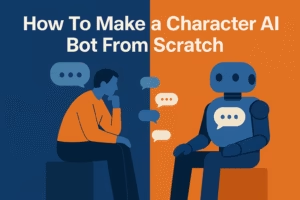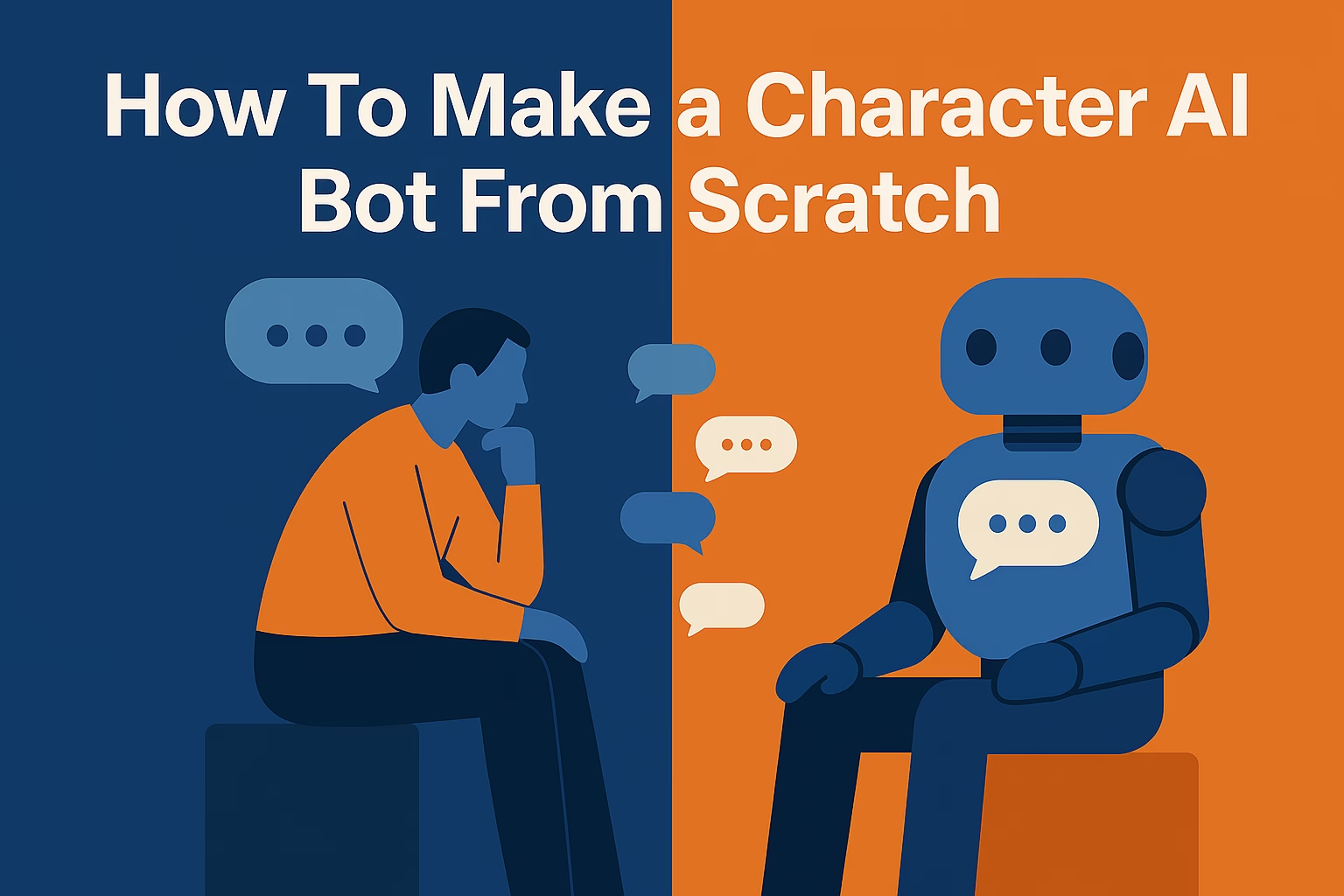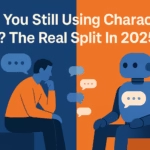Key Takeaways
- You only need two things to build a working bot: structure and patience.
- Keep your definition short and specific – clarity always beats lore.
- Use five example messages to train tone; they do more than adjectives ever will.
- Treat the first ten swipes like rehearsal, not dialogue – this locks tone early.
- Tools like Candy AI help test tone and memory safely before publishing.
- Progress comes from iteration, not perfection – edit, test, repeat.
If you have never built a bot before, the process can feel like trying to code with vibes. The truth is, you do not need to know any code.
You just need a clear skeleton. Every Character AI bot has two layers – the short description and the long definition.
The short one tells users what the bot is about in a single sentence. Think of it as a movie tagline. The long definition is where you tell the model who the bot is, how it thinks, and what tone it should keep.
Here is the simple rule: the short description is for humans, the long definition is for the AI. Use plain language, not prose. List key facts like name, role, attitude, and goal.
If the bot is a detective, write what drives them. If they are a classmate, describe their voice and the type of story you want. You are not writing lore, you are setting boundaries.
A good start looks like this:
“A calm and curious historian who interviews the user about ancient myths. Speaks politely, asks deep questions, and never rushes answers.”
That one line gives the model enough to build tone, pacing, and purpose.
Once you have this foundation, the rest becomes adjustment. The problem most beginners face is not imagination.
It is clutter. They fill the definition box like a diary, then wonder why the bot keeps losing track. Keep it short and specific. That is how you make the model obey, not improvise.

Token Discipline For Real People
Every Character AI bot lives within a token limit. Tokens are the building blocks of memory, and when you use too many, the AI forgets everything that came before.
The limit may look large, but in practice, it fills up fast. That is why your first skill as a creator is restraint. You are not writing a novel. You are writing a DNA code that the AI can read without choking.
The trick is to strip away filler and focus on signals. Instead of saying, “She has always been a kind, thoughtful, introspective person who loves helping others,” just say, “Kind and patient, speaks softly and helps others without judgment.”
It says the same thing in half the space, and the model will read it more accurately.
Another mistake is writing long backstories. The AI does not care that your bot’s grandmother owned a tea shop in the mountains unless it affects how they talk.
Save that for the roleplay later. Every word that does not shape the bot’s behavior is wasted space.
If you need more room, use brackets or lists. They compress meaning without adding noise. For example:
Personality: calm, loyal, analytical
Motives: uncover truth, protect others, avoid conflict
It looks mechanical, but it works. Remember, the goal is not to impress readers. The goal is to teach the machine how to behave.
Personality That Actually Sticks
A character’s personality is not how they look but how they react. The reason most bots sound generic is that creators describe surface traits instead of inner rhythm.
Words like “kind,” “funny,” or “confident” do nothing unless the AI knows how those traits sound in conversation.
Start by picking three anchor traits. That is enough to make the bot consistent without turning it robotic. For example, “playful, impatient, and curious” gives the AI a clear emotional compass.
Add a motive – “wants to understand people but hides it behind sarcasm.” That motive stops the bot from replying the same way every time.
The simplest formula looks like this:
Trait + Trait + Trait + motive behind behavior + tone of speech
That’s it. You can even test it by imagining how your bot would respond to a question like, “How are you today?” If every answer feels identical, the definition is too vague. Add contrast until the voice feels alive.
And remember, emotion drives consistency. A bot that feels something, even something subtle, will respond in a pattern that makes sense. A bot that just “is nice” will fall apart in three messages.
Make it care about something – even if that thing is small.
The Definition That Does The Heavy Lifting
This is where everything comes together. The definition box is not a story, it’s a command manual.
Think of it as the invisible script that the AI reads before every message. When you write it right, the bot feels smart. When you stuff it with fluff, it feels confused.
Here’s a clean, reusable structure that works for almost any bot:
Name:
Role:
Personality: [three traits, one motive]
Speech Style: [tone, rhythm, vocabulary level]
Setting: [short context if relevant]
Rules: [what to avoid or emphasize]
Memory: [facts the AI should not forget]
Each line is optional, but together they give the AI everything it needs to stay in character. Avoid paragraphs. Use short sentences. The model reads better that way.
If you want to show how your character reacts in practice, add one or two example replies inside parentheses. Something like:
(Example: “You really think that’s wise?” he says quietly, adjusting his glasses.)
That helps the AI match style and tone without draining tokens.
Most of all, never copy definitions from other bots or wikis. The language they use often confuses tone. Write it in your own words, as if you’re explaining to a friend who your character is.
When the AI reads natural phrasing, it writes natural dialogue back.
Five Example Messages That Train Style
Once your bot has a solid definition, it needs examples – short, believable replies that show how it should sound. These are what shape rhythm and pacing far more than adjectives ever could. Most beginners skip this step and end up with flat or robotic dialogue. The secret is variety. Give the AI a few small windows into your character’s voice.
Think of these five messages as mini rehearsals:
- Greeting – A natural introduction that shows warmth, attitude, or caution.
Example: “Oh, you again. Did you bring snacks this time?” - Neutral scene – A calm, everyday tone. How your bot talks when nothing dramatic is happening.
- Tension moment – A response where emotion leaks through, like fear or frustration.
- Reveal scene – A moment of honesty or vulnerability that defines the core personality.
- Recovery scene – A return to composure, humor, or routine. It shows how your bot resets after emotion.
Each one should be short, natural, and free of narration clutter. No long exposition or stage directions. The goal is to make the AI feel what kind of rhythm you want.
These five are enough to train tone without overwhelming the system. When done right, you will notice the bot start to “breathe” on its own.
Memory Notes Without The Bloat
Memory is the difference between a chatbot and a companion. But the box labeled “memory” is not a diary. It is a cheat sheet. You should only include what defines who the bot is and how it relates to the user. Anything else is noise.
A good memory note is short, factual, and timeless.
For example:
- Knows the user’s name is {{user}}
- Understands the setting is modern day
- Remembers personal tone and boundaries
That is all you need. Resist the urge to add emotional monologues or past events. Those belong in the conversation, not in storage. The more you cram into memory, the more the AI has to juggle, and it starts blending details or forgetting important ones.
The trick is to think of memory as a backbone, not a script. You can always edit it later as your world evolves. If your bot suddenly starts mixing up facts or tones, prune the memory box, not the whole definition. It is usually confusion, not decay.
A clean memory setup is what makes bots feel consistent months later. It is invisible work that pays off every time you chat.
The First Ten Swipes
The first few minutes you spend testing a new bot decide how well it will perform forever.
The AI learns tone through repetition. If the first ten messages are messy, it anchors to that chaos. That is why seasoned creators treat the first ten swipes like rehearsal, not conversation.
When you launch a new bot, start with calm, neutral prompts. Avoid emotional or complex scenes right away. You are teaching the model to listen. If it misfires – wrong tone, wrong pronouns, wrong pacing – do not argue with it.
Swipe. Delete. Try again. Editing or correcting it mid-scene just reinforces the mistake.
Every successful creator uses this loop: swipe bad lines fast, highlight good ones by continuing the thread, and stay consistent with your own writing style. Once the AI catches the rhythm, it will mimic it faithfully. You can then start adding emotion, conflict, or humor.
Ten patient swipes can save you hours of frustration later. Think of it like tuning an instrument — you don’t start the concert until it sounds right.
Multi-Character Worlds
Sometimes one bot is not enough. You want group dynamics, rivalries, or storylines that need multiple voices. That is when creators build multi-character worlds. You can do this two ways.
Option one: create separate bots and add them to a shared chat. This keeps each one consistent but requires more setup. You’ll need to guide scenes clearly, making sure each character has a role.
The upside is stability. Each bot remembers its tone.
Option two: create a single bot with a controlled internal cast. You describe how each side character behaves inside the same definition, then add rules to keep them distinct. For example:
(Bot plays all side characters but never confuses them with {{user}}. Each side character speaks in third person and stays true to its personality.)
This approach saves time but demands clarity. Overload it, and your characters start blending into one monotone chorus. Keep it small – two or three side figures at most.
The trick is direction. AI follows structure, not intent. Give it clean cues, short names, and clear voice differences. The moment roles blur, the world collapses.
Multi-character setups can be powerful, but they only work when you think like a director, not a writer. Keep your stage neat, your script minimal, and your edits decisive.
Winding Up
Most people overthink their first bot. They keep waiting to feel “ready,” but readiness never comes.
The truth is, the best bots come from trial and error, not perfection. Each mistake teaches the AI – and you – how to write tighter, cleaner, and smarter.
Creating your own Character AI bot is not about mastering the interface. It is about learning how to guide a model without losing your voice. Once you see that, it becomes less like coding and more like collaboration.
Start small. Build one bot. Test it. Break it. Fix it. Every edit you make is data the AI uses to understand you better.
Before long, the lines between prompt and personality start to blur, and that’s when you realize you’re no longer training a bot; you’re writing a partner.
If you want a shortcut to see what balanced storytelling looks like in practice, explore Candy AI.
It is one of the few platforms that keeps memory, tone, and creative freedom intact. Not perfect; but honest. And that honesty is what most creators are missing.
So do not wait for inspiration. Open the editor. Type a sentence. You will fix it later – you always do.


